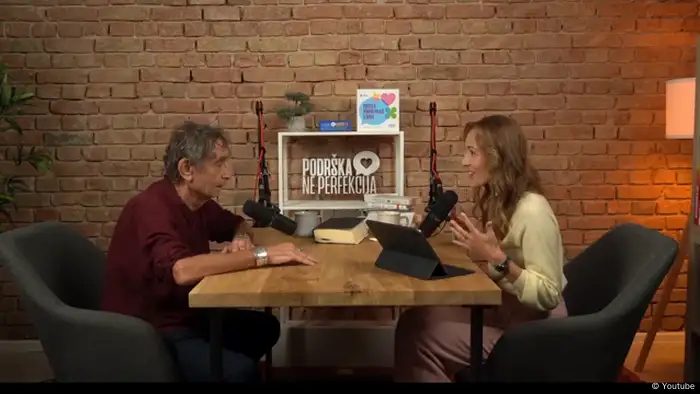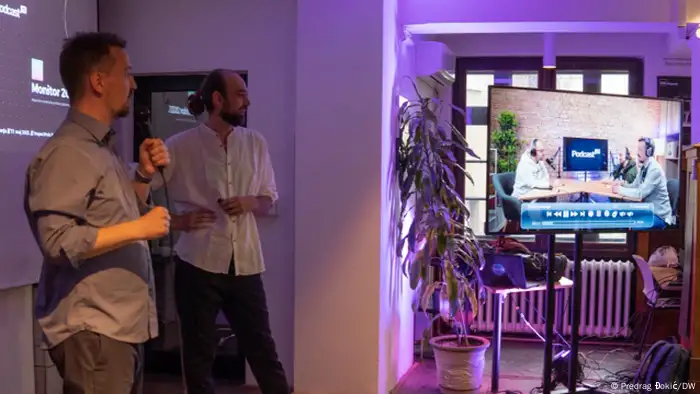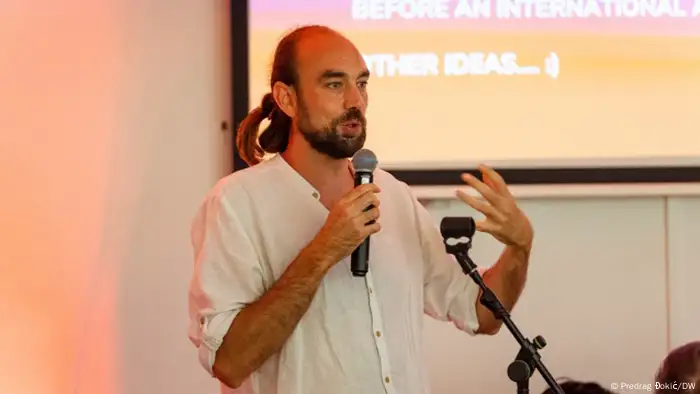Podcasting
Lights, camera, conversation: Vladimir Radinović of Serbia’s podcast.rs unpacks the pros and cons of video podcasting
Video podcasting is gaining traction these days. Does adding visuals to the voices make sense? The co-founder of Serbia’s leading podcasting platform spoke to the PodCircle about video’s benefits and challenges.

YouTube screenshot Dr. Gabor Mate in conversation with Jelena Đoković during the recording of Podrška ne perfekcija at the podcast.rs studio
Vladimir Radinović is the co-founder of Podcast.rs, Serbia’s leading podcast aggregator and production company. The idea of the company came out of a media hackathon in 2019 which Vladimir won along with Goran Vojteški. The two decided to team up and Podcast.rs was born. They wanted to show people in the region, where podcasting was just getting started, what local content was available and to connect the producers with audiences. From 15 podcasts in 2019, the site now features more than 460 regional podcasts in the Serbian, Croatian and Bosnian languages as well as podcasts by authors from the diaspora and shows in minority languages—even some in English. They also offer production services and work with individuals, civil society groups and corporate clients.
Vladimir has a background in community radio and today is the president of the Community Media Forum Europe. About a decade ago, he started noticing that people’s media consumption habits were changing. They wanted to listen to content on demand instead of according to a set schedule. That’s when he began moving into IT solutions for radio content and eventually to founding Podcast.rs.
Last year, the company opened a recording studio in the center of Belgrade which expanded its capabilities to include video production services.
DW Akademie: Your background is very much linked to radio and audio formats. How did the move to adding video to the mix happen?
Vladimir Radinović: In Serbia, we jumped over a step that you saw in the US and Western Europe, where audio podcasts were the norm and then people started slowly moving into video formats. In Serbia, producers went straight to video on YouTube. Here, YouTube has always been the go-to platform for everything, including music. Everyone is there and so it's much easier to get bigger viewer numbers. Potential advertisers are more interested if you have 100,000 views on YouTube than having 10,000 listens on audio platforms. Currently, the biggest podcaster here in Serbia, Galeb Nikačević, followed the Joe Rogan approach and started his video podcast Agelast on YouTube. After a year and a half, he reached a million views on one episode. We’ve seen that podcasters on the platform can start making a profit after two or three months. So I think more and more podcasts nowadays immediately start with video. If we’re doing a podcast with someone who wants to make money on it, we say they need to be on YouTube.
Besides the monetization benefits, what other advantages to video do you see?
One is that the content is available on YouTube, which they use anyway, so they don't have to switch between apps to find their podcasts. Another thing is the comments section. People can leave comments and engage with the podcast, something you can’t do on the audio apps. This can be really good, especially for smaller shows. We worked with a guy who ran a cooking school and started a podcast on food. He’d only get about 3,000 views on YouTube, but the comments section was really engaging, full of mostly positive comments and interesting ideas. He would interact with the audience there and developed a very good relationship with them. That developed into meet-ups with listeners and really good sponsorship deals, because advertisers in his niche saw that he had a really dedicated, loyal group of fans, even though it wasn’t huge.
So audience engagement and community building can benefit. What else?
Video is very social media friendly. To promote an audio podcast on social media, you have to create some kind of an audiogram. And it's not as appealing as a video of someone talking. And again, the reach is just different. There’s a podcast recorded in our studio about Serbian trap music. They get about 80,000 views on YouTube. But then they pull out short clips and put them on TikTok and reach 1.5 million people.

Vladimir with podcast.rs co-founder Goran Vojteški. The company has added video to its production services portfolio
What do you say the audio purists out there who are dismissive of video podcasts?
When we started, we were also against video. It depends on what you want to do and what you want to achieve. I still think that a quality, narrative-driven audio story is better than any video podcast you can make. But if you want to make money and become commercial, then choose video. Or at least make your audio available on YouTube. Sponsors in Serbia were just not happy enough with host-read ads on audio platforms. And promo codes don't work that well in countries where e-commerce isn’t that developed.
What kind of formats work for video?
Shows with one person talking, very host driven, can work well in video format. Panel shows also, people talking about or analyzing a topic. Yeah, mostly those focused on chit-chat, interviews, that kind of thing. But anything that has a lot of editing and is more documentary style, a very narrative-driven piece or even a radio drama, it’s a different story. They don’t offer so many options for monetization in video format because you have to have the audiogram. Or they’re very expensive to produce because if you add video you end up having produced a TV documentary or a film.
Let's say a producer does audio and wants to add a pretty basic video component. Do they need to learn a completely new set of skills?
I think it can be done pretty easily nowadays. The biggest problem is the money you have to invest. A good camera costs at least 1,000 euros, and you need three if you want to do the basic podcast setup nowadays: one camera on the host, one on the guest and one for a wide shot. You need three stands, good lightning and some kind of a video mixer. And at the end of the day, you have to invest in a studio.
Can’t you do it in your bedroom or kitchen?
Yes, but it can become an organizational problem. Sometimes the children are there, or the dog is barking and jumping all over the equipment. Maybe someone’s drilling next door. Something can always go wrong. Or, you have to change the whole setup every time you record, moving the furniture around in your bedroom for each episode. That might be fun at first, but people soon get tired of it.
What’s the minimum you need if you want to go the inexpensive route?
You can start with two cameras, one on the guests and one on the host. Two stands for them and microphones. Then you need an audio interface to plug in the microphones. And then, if you don't do your own video editing you need some kind of a video mixer to do the video live. And lights and cables to connect everything. With all that, you’re looking at probably between 3,000 and 5,000 euros. You can maybe find these things used and bring down costs.
And skills? Is it hard to learn how to work with video?
No. We have people who work with us who never had experience in anything related to video. It takes them one session to learn it. It’s not like you’re taping a live sports event. You just switch the camera from one person to the other. When we were learning ourselves, we just went through a bunch of tutorials from YouTube and tested the things in our studio, seeing what worked and what didn’t.
Other challenges you see with video?
The YouTube algorithm. Because of that, you have to produce content once a week minimum. Otherwise, the algorithm will think you're just fooling around and won’t show your content to other people. So the video podcast really becomes your work. Most of the people that we know try to record episodes in advance, so they can potentially have a vacation or even be sick from time to time.
What kind of video editing platforms or programs do you would you recommend?
There are always the professional ones that people use, such as the Adobe Premiere. But we tried to remove that aspect from our production because it takes more time and adds another cost. We edit everything live. My advice to podcasters would be to invest 200-300 euros in a video mixer. You do all the mixing live so as soon as the podcast is done you basically have a finished product.
DW recommends
- Date 30.04.2024
- Author Kyle James (interview)
- Feedback: Send us your feedback.
- Print Print this page
- Permalink https://p.dw.com/p/4fM2N
- Date 30.04.2024
- Author Kyle James (interview)
- Send us your feedback.
- Print Print this page
- Permalink https://p.dw.com/p/4fM2N

